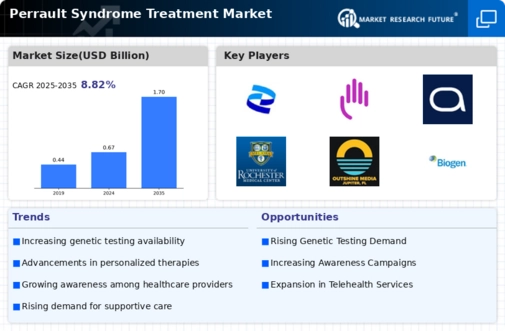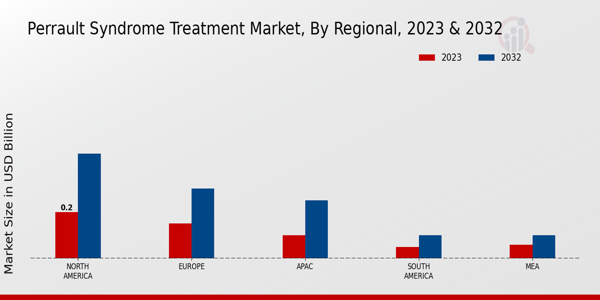Market Growth Projections
The Global Perrault Syndrome Treatment Market Industry is projected to experience substantial growth in the coming years. With an estimated market value of 0.67 USD Billion in 2024, the industry is poised for significant expansion. By 2035, the market could reach approximately 1.7 USD Billion, reflecting a robust growth trajectory. The anticipated compound annual growth rate of 8.82% from 2025 to 2035 underscores the increasing demand for effective treatment options and the ongoing advancements in genetic research. This growth is likely to be driven by a combination of factors, including rising awareness, government initiatives, and improved healthcare accessibility.
Advancements in Genetic Research
Recent advancements in genetic research play a crucial role in shaping the Global Perrault Syndrome Treatment Market Industry. Innovations in gene therapy and personalized medicine are paving the way for targeted treatments that address the underlying genetic causes of Perrault Syndrome. These developments not only enhance treatment efficacy but also improve patient outcomes. As research continues to evolve, it is anticipated that new therapeutic options will emerge, potentially increasing the market's value. By 2035, the market could reach an estimated 1.7 USD Billion, reflecting the impact of these scientific breakthroughs on treatment availability and effectiveness.
Government Initiatives and Funding
Government initiatives and funding for genetic research and treatment options are pivotal in advancing the Global Perrault Syndrome Treatment Market Industry. Many countries are investing in healthcare programs aimed at improving the diagnosis and treatment of genetic disorders. These initiatives often include grants for research, subsidies for genetic testing, and support for healthcare providers. Such funding not only enhances the availability of treatment options but also encourages innovation in therapeutic approaches. As a result, the market is likely to benefit from increased investment, which could lead to a more robust infrastructure for managing Perrault Syndrome.
Rising Incidence of Infertility Issues
The rising incidence of infertility issues among women, often linked to genetic conditions like Perrault Syndrome, is a significant driver of the Global Perrault Syndrome Treatment Market Industry. As more couples seek assistance with fertility, healthcare providers are increasingly recognizing the role of genetic factors in reproductive health. This awareness is likely to lead to a higher demand for genetic testing and counseling services, which are essential for diagnosing Perrault Syndrome. Consequently, the market is expected to grow, with projections indicating a compound annual growth rate of 8.82% from 2025 to 2035, as more individuals pursue effective treatment options.
Increasing Awareness of Genetic Disorders
The growing awareness of genetic disorders, including Perrault Syndrome, significantly influences the Global Perrault Syndrome Treatment Market Industry. Educational campaigns and initiatives by healthcare organizations are enhancing public understanding of this condition, leading to earlier diagnosis and treatment. As awareness increases, more individuals seek medical advice, which may drive demand for specialized treatments. This trend is particularly evident in regions with advanced healthcare systems, where genetic testing and counseling services are becoming more accessible. Consequently, the Global Perrault Syndrome Treatment Market is expected to expand as healthcare providers respond to the rising need for effective management strategies.
Emerging Markets and Healthcare Accessibility
Emerging markets are becoming increasingly important in the Global Perrault Syndrome Treatment Market Industry, as healthcare accessibility improves in these regions. Countries in Asia and Latin America are witnessing a rise in healthcare investments, leading to better diagnostic and treatment facilities for genetic disorders. This trend is expected to drive demand for Perrault Syndrome treatments, as more patients gain access to necessary healthcare services. The market's growth in these regions may contribute to a more diverse range of treatment options, ultimately enhancing patient care and outcomes.






















